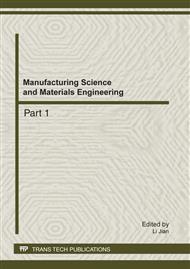[1]
Adleman, L.M., 1994. Molecular computation of solutions to combinatorial problems, Science, 266 (5187), 1021–1023.
DOI: 10.1126/science.7973651
Google Scholar
[2]
Lipton R J, DNA solution of hard computation problem, Science, 1995, 268(5210):542-545.
Google Scholar
[3]
Ouyang Q,Kaplan P D,Liu S M,et al.DNA solution of the maximal clique problem, Science,1997,278(17):446—44.
Google Scholar
[4]
Head T, Rozenberg G., Bladergroen R B. et al. Computing with DNA by operating on plasmids, Biosysterns,2000,57(2):87— 93.
Google Scholar
[5]
Sakamoto K., Gouzu H., Komiya K,et al. Molecular computation by DNA hairpin formation, Science,2000,288(5):1223-1226.
DOI: 10.1126/science.288.5469.1223
Google Scholar
[6]
Y. W. Cao, R. C. Jin, C. A. Mirkin, "DNA-modified core-shell Ag/Au.
Google Scholar
[7]
Nanoparticles, " J. Am. Chem. Soc, 2001, 123(32), 7961-7962.
Google Scholar
[8]
Braich R. S., Chelyapov N., Johnson C., et al. Solution of a 20-Variable 3-SAT Problem on a DNA Computer., Science, 2002, 296: 499-502.
DOI: 10.1126/science.1069528
Google Scholar
[9]
Kai Zhang, Jin Xu, Xiutang Geng, Jianhua Xiao, Lingqiang Pan, Improved taboo search algorithm for designing DNA sequences, Progress in Natural Science, 18(2008), 623-627.
DOI: 10.1016/j.pnsc.2008.01.005
Google Scholar
[10]
Pan Lingqiang, Xu Jin, Liu Yachun, A Surface-Based DNA Algorithm for the Maximal Clique Problem, Chinese Journal of Electronics, 11(2) (2002), 469-471.
Google Scholar
[11]
Dustin J, Maxwell, Jason R. Taylor, Shuming Nie. Self-assembled nanoparticle probes for recognition and detection of biomolecules, JACS, 2002, 124, 9606-9612.
DOI: 10.1021/ja025814p
Google Scholar
[12]
S. M. Nie, S. R. Emory, Probing single molecules and single nanoparticles by surface-enhanced Raman scattering, Science, 275(1997), 1102-1106.
DOI: 10.1126/science.275.5303.1102
Google Scholar
[13]
J. T. Krug, G. D. Wang, S. R. Emory, S. Nie, Efficient Raman enhancement and intermittent light emission observed in single gold nanocrystals, J. AM. Chem. Soc, 1999, 121(39), 9208-9214.
DOI: 10.1021/ja992058n
Google Scholar


